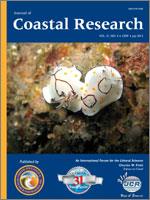Kidder, G.W.; White, S.; Miller, M.F.; Norden, W.S.; Taylor, T., and Disney, J.E., 2015. Biodegradable grids: An effective method for eelgrass (Zostera marina) restoration in Maine.
Restoration of eelgrass (Zostera marina L.) beds is often done by tying vegetative plants to wire grids and transferring them to the ocean bottom. In our experience, rhizomes can grow over the grids, resulting in a significant loss of transplants when the grids are removed. We have tested two other methods that circumvent this problem that have proved successful in Maine. First, we “stapled” eelgrass plants into subtidal areas using bent bamboo skewers. This method is effective and avoids grid-removal losses but is slow, is laborious, and requires workers with equipment. More recently, we constructed a novel biodegradable grid (BDG) with spruce side rails, laced with sisal twine and weighted with small sandbags. We find that BDGs are even more successful than wire grids at establishing transplants and that the losses from grid removal are eliminated. BDGs are an effective way of involving citizens in eelgrass restoration projects while increasing the success rate of transplants and saving labor.





